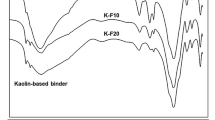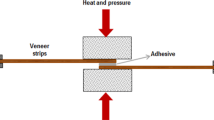Abstract
Geopolymer was used as a multifunctional mineral binder to produce laminated veneer lumber (LVL). The main aim of the study was to characterize the various geopolymer binder formulations based on natural kaolin, metakaolin and silica fume. The effect of different combinations of aluminosilicate powder in geopolymer binder was characterized via FTIR, XRD and TGA analysis. The mechanical (shear, bending, and compression) and physical (thickness swelling and water absorption) properties of the LVL specimens were also evaluated. Results showed that characteristic bands attributed to the geopolymer binder were more pronounced with further replacement of kaolin with metakaolin and silica fume. The higher the metakaolin content, the greater the amorphous content of the reaction products. The mechanical properties of the LVL samples strongly depended on the unreacted components (Si and Al molecules) existing in the aluminosilicate powder as well as the Si/Al ratio in geopolymer binders. The content of unreacted components was reduced by decreasing of the kaolin content in the binder formulations. Furthermore, increasing of Si/Al ratio, via addition of silica fume, showed positive influence on kaolin-based binders, while it showed a slightly negative influence on metakaolin-based binders. Although metakaolin is more favored for geopolymer synthesis due to its better mechanical, chemical, thermal and durability properties, the combination of kaolin with metakaolin could enhance its characteristics to be used as an aluminosilicate source for geopolymer binder. Kaolin-based binders showed higher tendency to penetrate into the wood cell lumens compared to metakaolin-based binders.










Similar content being viewed by others
References
Bahrami M, Shalbafan A, Welling J (2019) Development of plywood using geopolymer as binder: effect of silica fume on the plywood and binder characteristics. Eur J Wood Prod 77:981–994
Berzins A, Morozovs A, Van den Bulcke J, Van Acker J (2017) Softwood surface compatibility with inorganic geopolymer. Adv Mater Proc 2:793–798
Chen L, Wang Z, Wang Y, Feng J (2016) Preparation and properties of alkali activated metakaolin-based geopolymer. Materials (Basel) 9:1–12
Detellier C (2018) Functional kaolinite. Chem Rec 18:868–877
Direske M, Wenderdel C, Krug D (2018) Cement as an inorganic binder for the production of formaldehyde free bonded plywood. PRO Ligno 14:16–22
EN 14279 (2009) Laminated veneer lumber (LVL)—Definitions, classification and specifications (including Amendment A1:2009), European Norm EN 14279, European Committee for Standardization, Brussels, Belgium
EN 310 (1993) Wood-based panels-determination of modulus of elasticity in bending and of bending strength, European Norm EN 310, European Committee for Standardization, Brussels, Belgium
EN 314-1 (2005) Plywood-bonding quality—part 1: test methods, European Norm EN 314-1, European Committee for Standardization, Brussels, Belgium
EN 317 (1993) Particleboards and fibreboards. Determination of swelling in thickness after immersion in Water, European Norm EN 317 European Committee for Standardization, Brussels, Belgium
EN 408 (1995) Timber structures—structural timber and glued laminated timber—determination of some physical and mechanical properties, European Norm EN 408, European Committee for Standardization, Brussels, Belgium
Ermeydan M, Cabane E, Hass P, Koetz J, Burgert I (2014) Fully biodegradable modification of wood for improvement of dimensional stability and water absorption properties by poly(ε-caprolactone) grafting into the cell walls. Green Chem 16:3313–3321
Heah CY, Kamarudin H, Mustafa Al Bakri AM, Musa L, Nizar K, Liew YM (2011) Potential application of kaolin without calcine as greener concrete: a review. Aust J Basic Appl Sci 5:1026–1035
Heah CY, Kamarudin H, Mustafa Al Bakri AM, Bnhussain M, Luqman M, Nizar IK, Ruzaidi CM, Liew YM (2013) Kaolin-based geopolymers with various NaOH concentrations. Int J Miner Metall Mater 20:313–322
Hemmilä V, Adamopoulos S, Karlsson O, Kumar A (2017) Development of sustainable bio-adhesives for engineered wood panels—a review. RSC Adv 7:38604–38630
Jin S, Li K, Li J, Chen H (2017) A low-cost, formaldehyde-free and high flame retardancy wood adhesive from inorganic adhesives: properties and performance. Polymers (Basel) 9:513
Khater HM (2013) Effect of silica fume on the characterization of the geopolymer materials. Int J Adv Struct Eng 5:1–10
Kiele A, Vaičiukyniene D, Tamošaitis G, Pupeikis D, Bistrickaite R (2020) Wood shavings and alkali-activated slag bio-composite. Eur J Wood Prod 78:513–522
Kljajević LM, Nenadović SS, Nenadović MT, Bundaleski NK, Todorovic BZ, Pavlovic VB, Rakocevic ZL (2017) Structural and chemical properties of thermally treated geopolymer samples. Ceram Int 43:6700–6708
Kurt R (2010) Suitability of three hybrid poplar clones for laminated veneer lumber manufacturing using melamine urea formaldehyde adhesive. BioResources 5:1868–1878
Lecomte I, Liégeois M, Rulmont A, Cloots R, Maseri F (2003) Synthesis and characterization of new inorganic polymeric composites based on kaolin or white clay and on ground-granulated blast furnace slag. J Mater Res 18:2571–2579
Markets and Research (2020) Global laminated veneer lumber (LVL) market 2020 by manufacturers, regions, type and application, forecast 2025. Markets and Research.BIZ, Maharashtra, India
Merabtene M, Kacimi L, Clastres P (2019) Elaboration of geopolymer binders from poor kaolin and dam sludge waste. Heliyon 5:e01938
Nmiri A, Duc M, Hamdi N, Yazoghli-Marzouk O, Srasra E (2019) Replacement of alkali silicate solution with silica fume in metakaolin-based geopolymers. Int J Miner Metall Mater 26:555–564
Nzokou P, Zyskowski J, Boury S, Kamdem DP (2005) Natural decay resistance of LVL made of veneers from durable and non-durable wood species. Holz Roh Werkst 63:173–178
Petrič M (2018) Influence of silicon-containing compounds on adhesives for and andhesion to wood and lignocellulosic materials: a critical review. Rev Adhes Adhes 6:26–81
Prud’homme E, Michaud P, Peyratout C, Smith A, Rossignol S, Joussein E, Sauvat N (2010) Geomaterial foam to reinforce wood. Strateg Mater Comput Des Ceram Eng Sci Proc 31:3–10
Prud’homme E, Michaud P, Joussein E, Peyratout C, Smith A, Arrii-Clacens S, Clacens JM, Rossignol S (2010) Silica fume as porogent agent in geo-materials at low temperature. J Eur Ceram Soc 30:1641–1648
Sarmin SN, Welling J, Krause A, Shalbafan A (2014) Investigating the possibility of geopolymer to produce inorganic-bonded wood composites for multifunctional construction material—a review. BioResources 9:7941–7950
Shalbafan A, Thoemen H (2020) Geopolymer-bonded laminated veneer lumber as environmentally friendly and formaldehyde-free product: effect of various additives on geopolymer binder features. Appl Sci 10:593
Shalbafan A, Welling J, Hasch J (2016) Geopolymers as potential new binder class for the wood based composite industry. Holzforschung 70:755–761
Shalbafan A, Welling J, Hasch J (2017) Effect of aluminosilicate powders on the applicability of innovative geopolymer binders for wood-based composites. Eur J Wood Prod 75:893–902
Shalbafan A, Nadali A, Thoemen H (2020) A multifunctional mineral binder for plywood production: the effect of manufacturing parameters on bonding quality. Materials 13:2360
Shukla SR, Kamdem DP (2009) Properties of laboratory made yellow poplar (Liriodendron tulipifera) laminated veneer lumber: effect of the adhesives. Eur J Wood Prod 67:397–405
Singh NB, Middendorf B (2020) Geopolymers as an alternative to Portland cement: an overview. Constr Build Mater 237:117455
Solt P, Konnerth J, Gindl-Altmutter W, Kantner W, Moser J, Mitter R, van Herwijnen HWG (2019) Technological performance of formaldehyde-free adhesive alternatives for particleboard industry. Int J Adhes Adhes 94:99–131
Tchadjie LN, Ekolu SO (2018) Enhancing the reactivity of aluminosilicate materials toward geopolymer synthesis. J Mater Sci 53:4709–4733
Van Jaarsveld JGS, Van Deventer JSJ, Schwartzman A (1999) The potential use of geopolymeric materials to immobilise toxic metals: Part II. Mater Leaching Charact Miner Eng 12:75–91
Xu H, Van Deventer JSJ (2000) The geopolymerisation of alumino-silicate minerals. Int J Miner Process 59:247–266
Ye H, Zhang Y, Yu Z, Mu J (2018) Effects of cellulose, hemicellulose, and lignin on the morphology and mechanical properties of metakaolin-based geopolymer. Constr Build Mater 173:10–16
Acknowledgements
The authors would gratefully acknowledge Mr. Joachim Wolff from Imerys Fused Minerals GmbH for kindly supplying of metakaolin. Dr. Heiko Thoemen and Dr. Ingo Mayer from Bern University of Applied Sciences (Biel, Switzerlanad) are also acknowledged for their kind support to perform the TGA, FTIR and microscopic analysis.
Funding
This work was funded by Tarbiat Modares University, Iran.
Author information
Authors and Affiliations
Corresponding author
Ethics declarations
Conflict of interest
The authors declare no conflict of interest.
Additional information
Publisher's Note
Springer Nature remains neutral with regard to jurisdictional claims in published maps and institutional affiliations.
Rights and permissions
About this article
Cite this article
Allahverdipoorazar, F., Shalbafan, A. & Berthold, D. Geopolymer as a multifunctional mineral binder to produce laminated veneer lumber: effect of various aluminosilicate powder types on panels and geopolymer binder features. Eur. J. Wood Prod. 79, 349–362 (2021). https://doi.org/10.1007/s00107-020-01633-7
Received:
Accepted:
Published:
Issue Date:
DOI: https://doi.org/10.1007/s00107-020-01633-7




